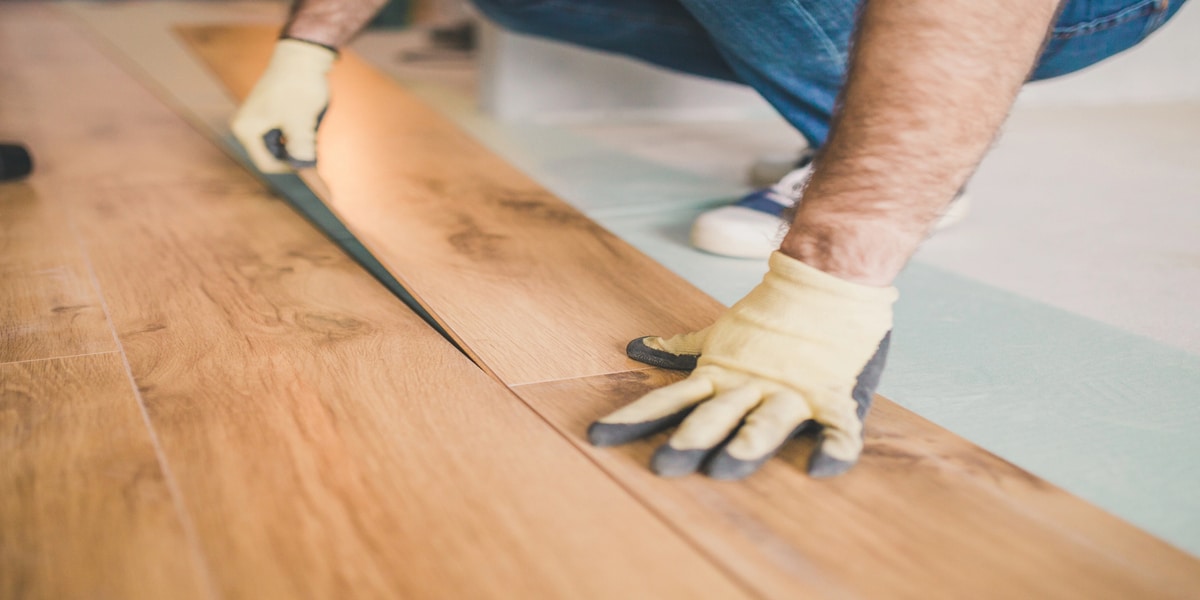Floating vs Nail-Down vs Glue-Down at High Elevation: Which Method and Why

At higher elevations above 5,000 feet, the floating installation method provides the best balance of performance and cost for homeowners dealing with dry, shifting climates. This flooring installation approach uses interlocking planks that “float” over the subfloor instead of being nailed or glued down. The design allows natural movement as hardwood flooring expands and contracts in response to thin mountain air and fluctuating humidity. Expansion gaps around walls and doorways absorb this motion, preventing warping or buckling that can occur in rigidly fastened systems.
For homes located between 3,000 and 5,000 feet, traditional nail-down flooring installation remains a strong option, particularly for engineered hardwood flooring. This approach relies on a stable base such as plywood or OSB panels, which provide the holding strength necessary for fasteners. Professional installers use pneumatic tools to drive cleats through the tongue-and-groove joints, locking the boards into place and creating a long-lasting, noise-resistant surface. While the initial cost is often higher than floating floors, the result is a solid, authentic feel underfoot that many homeowners prefer.
When working with concrete subfloors or environments that experience frequent moisture fluctuations, the glue-down method is the most reliable choice. This technique uses urethane-based adhesives that form a continuous, flexible membrane between the hardwood flooring and the slab. The barrier blocks vapor transmission that can damage wood fibers while reducing sound transfer between floors—an advantage for condominiums, commercial spaces, and multi-level homes. The glue-down method also minimizes movement during sudden drops in barometric pressure, which are common in mountain weather systems.
Each flooring installation technique responds to the unique challenges of high-altitude living. Atmospheric pressure drops roughly one inch of mercury for every 1,000 feet gained, altering how moisture interacts with wood and adhesives. During winter, humidity levels often fall below 30%, leading to contraction and visible gaps, while summer storms can raise moisture levels rapidly. Selecting the right installation method and acclimating materials properly ensures long-term stability, visual consistency, and the best return on investment for homeowners in mountain regions.
How Elevation and Climate Affect Flooring Stability
At higher elevations, flooring projects require careful attention to the installation process because air pressure and moisture behavior differ greatly from those at sea level. The thinner air in mountain regions holds less water vapor, which directly affects how solid hardwood and engineered materials respond after installation. Even when humidity meters show average readings, the lower atmospheric pressure means the air still contains less actual moisture, leading to faster drying and more pronounced wood movement.
Professional contractors understand that the installation time for solid hardwood floors at high altitudes often takes longer because the material must acclimate properly. This adjustment period allows the boards to reach equilibrium moisture content with the indoor air. Skipping or shortening this step often leads to gaps, cupping, or crowning once the heating season begins. A well-prepared wood subfloor and the right vapor barrier help regulate moisture transfer from below, reducing stress on the finished floor and preventing long-term structural issues.
For homes built on concrete slabs or in mixed-humidity environments, vinyl plank flooring provides a cost-effective alternative with shorter installation time and greater stability. Vinyl planks resist expansion and contraction, making them suitable for rooms where temperature and humidity fluctuate widely. Still, even these materials benefit from a vapor barrier to block moisture rising from below, particularly in basements or ground-level installations.
High-altitude flooring installations demand planning, precision, and patience. Contractors who work in mountain climates adjust fastener spacing, expansion gaps, and moisture targets to match local air pressure conditions. By following these detailed steps, they create durable floors that maintain shape and strength through seasonal shifts, protecting the homeowner’s investment for many years.
Floating Floors: Flexibility and Expansion Benefits
Floating floor systems give homeowners flexibility and durability, especially in mountain regions where air pressure and humidity change quickly. These systems do not attach to the subfloor below. Instead, each plank or tile connects only to the ones beside it, forming a stable surface that can expand and contract naturally without damage. This design makes them ideal for high-altitude flooring installation projects where moisture and temperature shifts happen more often.
How the Underlayment Works
The underlayment sits between the floating floor and the subfloor, serving two essential purposes:
- It acts as a vapor barrier to block moisture coming up from the wood or concrete subfloor.
- It allows the floating surface to slide slightly during natural expansion and contraction cycles.
At elevations above 5,000 feet, homes need underlayment with advanced moisture protection. Colorado’s mountain climate often shifts from 70% humidity in spring to as low as 20% in winter. These wide swings cause wood, laminate, and vinyl flooring materials to absorb and release moisture faster than in coastal regions.
Expansion Gap Requirements
Professional contractors leave expansion gaps around the floor’s edges to allow movement. These spaces usually measure between 3/8 and 1/2 inch, though high-elevation homes may require up to 5/8 inch.
- When humidity increases in summer, the planks expand into this space instead of pressing against walls or cabinets.
- Without this gap, pressure builds under the floor surface, causing buckling, cracking, or lifted boards.
Advantages Over Nailed or Glued Floors
Traditional methods like the glue-down method or nail-down installation limit how much a floor can move. Each attachment point becomes a stress location that resists expansion. Over time, this pressure leads to squeaks, gaps, and loosened fasteners.
Floating systems eliminate these risks. They rest freely on the underlayment, relying on their interlocking design and gravity to stay secure. When seasonal or elevation-related changes occur, the entire surface moves uniformly. This design keeps the floor level and stable through years of mountain weather, providing a cost-effective and low-maintenance option for homeowners seeking long-term flooring performance.
Nail-Down Floors: Durability and Structural Confidence
The nail-down method remains one of the most dependable approaches in flooring installation, especially for solid hardwood and engineered hardwood systems in mountain climates. Workers hammer nails or staples directly through each board into the wood subfloor, creating a secure and permanent bond. This tight connection removes the hollow sound or flexible feeling often noticed in floating installation methods, giving the floor a firm and stable surface underfoot.
In high-altitude areas where temperatures and humidity levels fluctuate dramatically, the nail-down process provides long-term stability. The consistent fastening pattern prevents cupping, warping, or shifting during seasonal changes. As dry winter air alternates with humid summertime conditions, nailed floors maintain their position without separating or lifting.
Professional contractors use pneumatic nailers during the installation process to drive each fastener at a precise 45-degree angle through the board’s tongue. Fasteners are spaced every 8 to 10 inches to ensure balanced tension across all planks. This careful method helps the floor resist the natural expansion and contraction cycles caused by environmental shifts.
Before installation begins, contractors verify that the wood subfloor—typically made from plywood or oriented strand board—is structurally sound, level, and securely fastened to the floor joists. These qualities are critical for holding nails firmly over time and preventing movement that could cause squeaks or unevenness. A vapor barrier may also be added between layers to block moisture from rising into the wood.
Although nail-down flooring installation increases labor time and overall project cost compared to floating or glue-down methods, the results justify the investment. Properly installed hardwood flooring can last 20 to 40 years without major repairs, offering both durability and value for homeowners. Engineered hardwood performs particularly well in mountain settings, where the combination of layered construction and secure fastening allows it to endure changes in altitude, pressure, and humidity while maintaining its natural beauty and strength.
Glue-Down Floors: Moisture Control and Acoustic Advantages
Adhesive-based flooring installation provides both structural strength and environmental protection, making it ideal for high-altitude homes and commercial spaces. The process begins when contractors spread a uniform layer of flooring glue over the subfloor surface, whether it’s made of concrete or plywood. Workers then position each plank carefully into the adhesive, forming a secure bond that doubles as a vapor barrier. This technique prevents water vapor from traveling upward through the subfloor, which is especially important in regions where humidity levels fluctuate widely between day and night. By sealing off moisture movement, the installation process protects hardwood flooring from warping, cupping, and long-term structural deterioration.
In addition to moisture control, glue-down flooring offers superior acoustic benefits. The adhesive layer fills every gap beneath the wood planks, eliminating air pockets that typically amplify sound in floating installations. This continuous bond reduces impact noise from footsteps and prevents vibration transfer between floors. In multi-story homes or commercial buildings, the difference in noise reduction can be dramatic, leading to quieter and more comfortable living or working environments.
Temperature changes present another challenge in mountain climates, where daytime heat gives way to cool nighttime air. These thermal shifts cause natural expansion and contraction in wood materials. Modern adhesive formulas solve this issue through flexible polymers that move with the wood instead of resisting it. As a result, the flooring remains firmly attached without the cracks or separation that occur with rigid glues.
This installation method offers long-term value for contractors and homeowners alike. It performs exceptionally well in multi-level residential buildings, condominiums, and office towers that demand both sound insulation and moisture resistance. The glue-down approach combines durability, comfort, and environmental stability—three essential qualities for any successful flooring installation in mountain or high-altitude environments.


















